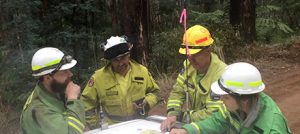Firefighters in Eastern Australia are capitalising on calmer weather conditions forecast for the rest of this week with authorities still unable to accurately assess the damage to harvestable timber stocks. Source: Timberbiz
In Victoria, where fires have burned an estimated 1.2 million hectares, the cooler weather and chance of widespread rain are expected to allow firefighters to carry out containment work and two emergency warnings have been downgraded.
The heavy falls are most likely about the ranges, with isolated daily totals in excess of 50mm underneath any storms that form.
A spokeswoman for Emergency Management Victoria’s state control centre said there were still live concerns, even though firefighters had experienced cooler weather overnight.
“Some of those fires are misbehaving and jumping around, so the fire danger is still very real. Emergency services are working hard to return access to roads and help people get back to their homes,” she said.
The expected thunderstorms could also cause lightning and flash flooding with fears the downpour could topple damaged trees and cause debris to run off onto roads and private property.
Emergency Management Victoria’s state control centre spokesman Luke Hegarty said bouts of heavy rainfall, forecast from this afternoon, would not help fight ongoing fires but could pose dangers to crews and communities.
“We are not expecting that good, broad, across-the-state rainfall that soaks in,” he said.
“It’s stuff that will come really quickly, really heavily and make the roads slippery for our crews, make it dangerous in terms of trees falling.”
A VicForests spokesperson said it was too early to fully assess the impact because the fires are ongoing.
“We can confirm that the East Gippsland fires have affected some areas where we have coupes.
“Our current focus is on fully supporting the efforts to manage the bushfires, deploying all available VicForests staff and contractors to the region.”
In NSW the Snowy Valleys are expecting temperatures in the 30s but with lighter winds and possible rainfall in the next few days.
Fire crews will consider back-burning if conditions allow.
“We might get a little shower on Wednesday and then we’ll consider back-burning on Thursday or Friday,” Rural Fire Service District Coordinator Peter Jones said.
“However, that is a lot of fire to put on the fire ground, so we don’t necessarily want to have to do it this close to getting on top of it.”
The place being considered for back-burning is in Kosciuszko National Park at the back of Goobarragandra, with the aim of protecting the Bondo State Forest.
Forestry Corp of NSW said that as of Monday, fires had impacted around 850,000 hectares of State forests in NSW including around 50,000 hectares of hardwood and softwood plantations.
However, it said it was too early to assess the detail of these impacts and it would be planning salvage harvest operations where it could as part of the recovery effort.
A Bureau of Meteorology spokesman said that convection activity in the atmosphere may bring rainfall as early as tomorrow.
“The IOD (Indian Ocean Dipole) is in a neutral phase creating tropical moisture in the air,” he said.
Showers will be widespread and heavy in some places.
Temperature-wise, the hottest day of this week in the Tumut area is likely to be today, with a top of 37C expected. A top of 33C is forecast for Tumbarumba.
The Bureau says the temperature will drop slightly tomorrow, with a maximum of 35 to 36 for Tumut and 32 for Tumbarumba. Winds will come from the north east at 15km/h then change to north west and lighten to 7 to 10km/h.
In the Green Triangle about 900 hectares of HPV’s plantation timber was reportedly hit by a fire near Dartmoor in Victoria’s south west in early January, but otherwise the region has escaped any serious blazes.
Queensland, apart from the occasion breakout, has been so far largely unaffected.
On Kangaroo Island, where fires are expected to continue burning for another two weeks, assessment of damaging is continuing with early indications that 80-90% of Kangaroo Island Plantation Timbers’ trees and all of the island’s independent plantations have been affected by fire.
A trough moving across the island will provide firefighters favourable wind conditions to tackle the “irregular” firefront, which is 120km long and has a perimeter of more than 550km.






